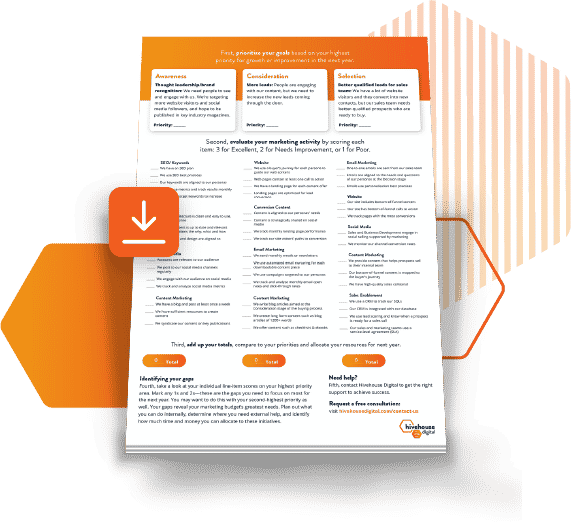
Oh, organic traffic – the sweet fruit of our digital marketing labor. You wouldn’t expect an apple orchard to magically spring from the ground and you shouldn’t expect organic traffic to start flowing to your website on its own. Just like those delicious Honeycrisp apples, organic traffic has to be cultivated and nurtured. That’s why we’re going to talk about “pillar pages”. One of the aptest names in digital marketing, pillar pages support a website’s content and in turn, drive that sweet, sweet organic traffic.
What is a Pillar Page?
Pillar pages, sometimes known as cornerstone content, are web pages or articles that act as a hub for your website’s most important content. We like to think of pillar pages as “Ultimate Guides to ____”. For example, here’s our Ultimate Guide to Digital Marketing For Manufacturers.
As you scroll through the guide, notice the breadth of info we cover – it even has a glossary. That’s not just because we’re digital marketing nerds, it’s because a great pillar page should touch on all areas of a topic, encouraging users to dig even deeper. To move users even further into your website, pillar pages should link to less broad, more niche, and detailed blogs or articles that are relevant to the pillar page’s topic.
Think of a bicycle wheel, a website’s pillar page is the hub and the spokes are links to relevant, specific articles. That’s how you create what is commonly referred to as a topic cluster. Pages or blogs orbiting a hub pillar page, covering one broad topic.
Just like soil and climate determine which crops a farmer grows, pillar pages determine what kind of content a website will be known for.
Why Pillar Pages?
The internet is always changing. You know that. Today’s hot new meme is tomorrow’s trash.
The way we search is changing too. More and more technology is being developed for voice search and as a result, more and more people are using it. You’ve seen them out and about, grown adults yelling “Hey Siri!” at their iPhones, searching for answers not just on the internet, but maybe about themselves.
Google and other search engines have built their search algorithms to reflect our more conversational approach to search.
If you’re old enough, you may remember a time when it was best practice to search in a keyword-heavy manner like, “Detroit Lions + Team Owners”. The only problem is, normal humans don’t speak in keywords, they talk about topics.
Google, the king of search, realized this around 2013 when they introduced a total rehaul of their search algorithm called Hummingbird.
As laid out here by Search Engine Journal, Google had 3 primary goals with Hummingbird:
- Improve Conversational Search
- Make Search More Human
- Build the Foundations of Voice Search
These improvements allowed Google Search to rely less on keywords and focus more on the user’s intent. What question is the user really trying to answer?
Head over to Google’s explanation of their search algorithm and you’ll find this, “To return relevant results for your query, we first need to establish what information you’re looking forーthe intent behind your query.”
After Hummingbird, Google was no longer just indexing keywords and hoping the results matched up with the user’s intention.
Now, Google is trying to figure out what you’re asking and which resources it can provide to best answer those questions.
So, what does that have to do with pillar pages? Well, it’s why pillar pages are a huge driver of organic traffic. To find the best answers to users’ searches, search engine algorithms have to rely on web pages that display a level of expertise. A pillar page, by linking to more detailed articles and exploring a broad subject area, is the foundation for building trust on a topic.
Organizing your content around a pillar page also makes it a lot easier for those search engines to quickly scan your website.
Pillar pages don’t just satisfy Google, they’re incredibly engaging for humans too. We’ve all gotten lost down an internet rabbit hole, one night you’re googling “texas hold ’em rules” and all of the sudden, it’s 2 am and you’re bleary-eyed, watching youtube highlights from the 2003 World Series of Poker.
Pillar pages, a lot of times, can be the genesis of those deep-dives. We often start with a broad topic search and continue to dig deeper into our topic cluster. This makes for more engaged users, who spend more time on your website and are more likely to revisit your resources.
Now that you understand the why, here’s the how.
How to Build Pillar Pages
Step 1 – Choose a Topic
This topic should be broad enough to fit plenty of content under its umbrella but not so broad it’ll get lost in the shuffle of other search engine results.
Unlike our buddy, the farmer, whose crops are usually determined by the climate of wherever he lives, your topic is determined by your website and business.
Here’s an example. We built a pillar page for EOS, a company that focuses on helping entrepreneurs build their business, called the Effective Team Meeting Guide for Entrepreneurs and Small Businesses.
That topic is right in the sweet spot (if we do say so ourselves). If we broadened the topic so it was just “Effective Meeting Guide” we wouldn’t be able to differentiate our pillar page from other pages we’re competing against.
By the same token, if we made the topic even more specific, the Effective Team Meeting Guide for Entrepreneurs and Small Businesses in the Marine Research Industry, it would be too specific to attract an audience and too specific to link much relevant content.
When selecting a topic it’s important to keep in mind Google’s focus on understanding user intent:
- What problems are you trying to solve for your customers?
- What kinds of questions are prospective customers asking?
Let’s say you run a website for a small guitar shop. You want to drive traffic for users who would like to purchase a guitar.
A guide to purchasing your first electric guitar would be a solid topic. It’s broad but could prove very useful to a new chunk of your target audience. It’s also a topic that can lead to much more specific content, like “Best Guitar Pedals for a Jazz Guitar Tone”.
Step 2 – Conduct Keyword Research
Now before you jump into building “The Face-Melting Guide to Purchasing Your First Electric Guitar” you may want to take some time to brainstorm the keywords you’d like your pillar page to rank for.
Then take those keywords and see what kind of relevant content ideas you can sketch out. Remember, for a pillar page to be successful, it needs content to anchor. Do your topic and the corresponding keywords naturally inspire additional relevant content?
Step 3 – Outline Your Pillar Page
Once your pillar page topic is chosen and your keywords researched, you should have some ideas for the content you’d like to create.
Before you start creating the content, this is a great point to move all of those whiteboard brainstormings into a solid, concrete pillar page outline. When you outline your pillar page, you’ll gain valuable insight into what type of content belongs on the pillar page, and what type of content should be saved for the surrounding topic cluster. This is also where you’ll determine how to incorporate your researched keywords. Break your pillar page down into sections, chart it out!
An outline can be your plan of attack and should help you and your team understand the scope of the project. Once your pillar page outline is complete, the next step is to start creating.
Building pillar pages isn’t easy. If you’d like to learn more about pillar pages or need help getting started on building your website’s search engine optimization strategy, we’d love to help. It’s not our first rodeo.
Too Long; Didn’t Read
In short, a pillar page is a long-form web page that covers a broad topic, which links to more detailed, niche web pages or articles. Search engines have changed over time to drive organic traffic to these types of web pages making them essential for a comprehensive inbound strategy.
Pillar pages, as the name implies, are a great place to start if you’re ready to get serious about driving organic traffic to your website. It’s a lot of work but when the website visitors start flowing, you’ll understand the juice is worth the squeeze.
Still Looking For Answers? We Can Help!
Get the latest news
Blog Topics
- Analytics
- Branding & Identity
- Budget
- Construction
- Content Marketing
- Conversion Rate Optimization
- Email Marketing
- HubSpot
- Inbound Marketing
- Lead Generation
- Marketing Strategy
- News/Events
- Paid Search & PPC
- Recruiting
- Sales & Marketing
- Sales Enablement
- Search Engine Marketing
- Search Engine Optimization
- Social Media
- Thought Leadership
- Uncategorized
- Usability
- Video Marketing
- Web Hosting
- Website Design


